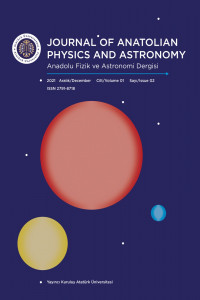GaTe Tek Kristalinin Sıcaklığa Bağlı Optik Karekterizasyonu
GaTe ikili yarıiletken bileşikleri, modifiye edilmiş Bridgman-Stockbarger kristal büyütme yöntemi ile elde edilmiştir. Büyütülen kristallerin yapısal, morfolojik, topolojik ve optiksel karakterizasyonları sırasıyla XRD, SEM, EDX, AFM ve soğurma ölçümleri ile gerçekleştirilmiştir. XRD analizleri sonucunda, GaTe ikili kristallerinin monoklinik yapıya sahip oldukları belirlenmiştir. Tavlama sıcaklığının yapı üzerindeki etkisini belirlemek amacıyla büyütülen kristaller çeşitli sıcaklık değerlerinde belirlenen süreler boyunca azot gazı ortamında tavlanmış ve tavlamadan hemen sonra XRD analizleri yapılmıştır. GaTe yarıiletkeni için EDX tekniği ile elde edilen atomik ağırlık değerleriyle büyütme esnasında hesaplanıp uygulanan değerleri birbirleriyle uyum içinde olduğu belirlenmiştir. Bileşiğin soğurma ölçümleri 10-320 K aralığında ve 10 K’lik adımlarla alınmış GaTe ikili bileşiklerine ait sıcaklığın bir fonksiyonu olarak soğurma katsayısı ve yasak enerji aralıkları hesaplanmıştır.
Anahtar Kelimeler:
GaTe, XRD, SEM, EDX, AFM, Soğurma Katsayısı, Band aralığı
Temperature Dependence of the Optical Characterizations of GaTe Single Crystal
GaTe binary semiconductor was grown by the modified Bridgman-Stockbarger technique. Absorption measurements, XRD, SEM, EDX and AFM were performed for structural, morphological and optical characterizations of the semiconductor. As a result of the XRD analyses, it was observed that GaTe binary semiconductor had monoclinic structure. To define the effect of annealing temperature on structure, the grown crystal annealed in a nitrogen gas environment at different temperatures in determined periods, after annealing XRD analyses were done. For GaTe semiconductor, atomic weight values that were obtained by the EDX technique and the values that were calculated during growth and applied agreed with each other. The absorption measurements of GaTe binary semiconductor was in the range of 10-320 K and these measures were performed for each 10 K steps. Energy band width and absorption coefficients were determined as a function of temperatures variable for GaTe single semiconductors.
___
- [1]B. Gürbulak, M. Şata, S. Dogan, S. Duman, A.Ashkhasi, and E. F. Keskenler, Physica E 64106–111 (2014).
- [2]M.M. Abdullah, G.Bhagavannarayana and M. A.Wahab: Journal of Crystal Growth 312, 1534–1537 (2010).
- [3]Yüksek, M., Ertap, H., Elmali, A., Yağlıoğlu, H.G.,Mamedov, G.M., Karabulut, M. and Öztürk, M.K.2012. Two photon absorption characteristics ofbulk GaTe crystal. Optics & Laser Technology,44), 2178–2181, (2012.
- [4]K.C., Mandal, R.M., Krishna, T.C., Hayes, P.G.,Muzykov, S., Das, T.S., Sudarshan and S., Ma,.IEEE TRANSACTIONS ON NUCLEAR SCIENCE,58(4), 1981-1986. (2011).
- [5]O. A., Balitskii, B., Jaeckel, and W., Jaegermann,Physics Letters A., 372, 3303-3306. (2008).
- [6]J., Camassel, P., Merle, H., Mathieu, and A., Chevy,1978. Physical Review B, 17(12), 4718. (1978)
- [7]A. G., Kunjomana, M.,Teena, and K. A.,Chandrasekharan.Journal of AppliedCrystallography, 47(6), 1841-1848. (2014)
- [8]Gauthier, M., Polian, A., Besson, J. M., and Chevy,A.,Physical Review B, 40(6), 3837. (1989).
- [9]V. P., Gupta, and V. K. Srivastava1981. Journal ofPhysics and Chemistry of Solids, 42(12), 1071-1077. (1981).
- [10]M. A., Rahman, and A. E., Belal. Journal of Physicsand Chemistry of Solids, 61(6), 925-929.(2000)
- [11]M. M. ,Nassary, 2006. Turkish Journal of Physics,30(2), 95-102. (2006).
- [12]K., Çınar, Z., Çaldıran, C., Coşkun, and Ş.,Aydoğan, Thin Solid Films, 550, 40-45. (2014)
- [13]J. J., Fonseca, S., Tongay, M., Topsakal, A.R.,Chew, A. J., Lin, , C., Ko... O. D., and Dubon,Advanced Materials, 28(30), 6465-6470. (2016)
- [14]Z., Rák, S. D., Mahanti, K. C., Mandal, and N. C.Fernelius, Solid State Communications, 150(27),1200-1203. (2010).
- [15]Z., Rák, S. D., Mahanti, K. C., Mandal, and N. C.Fernelius, Condensed Matter, 21(1), 015504.(2008).
- Başlangıç: 2021
- Yayıncı: Atatürk Üniversitesi
Sayıdaki Diğer Makaleler
Koronagrafın Astronomideki Uygulamaları
Burak Batuhan GÜRBULAK, İlham NASIROĞLU, Aykut ÖZDÖNMEZ, Hüseyin ER
Ashalul MOHAMUD, Fatima ALLOGHANİ, Waad ALHUSSEİN, Shams A.m. ISSA, Hüseyin Ozan TEKİN
Sevil PORİKLİ DURDAĞI, Ahmed Hasan Hashim AL-JALAWEE, Fatma GÜZEL
ATA50 Teleskobunda Gece Gökyüzü Kalitesi Ölçümleri
GaTe Tek Kristalinin Sıcaklığa Bağlı Optik Karekterizasyonu
Bekir GÜRBULAK, Mehmet ŞATA, Afsoun ASHKHASI, Burcu AKÇA, Songül DUMAN
Antimonun 59.54 keV'de L Alfa ve L Beta X-Işınlarının Açısal Dağılımı
